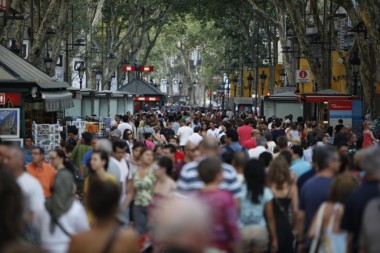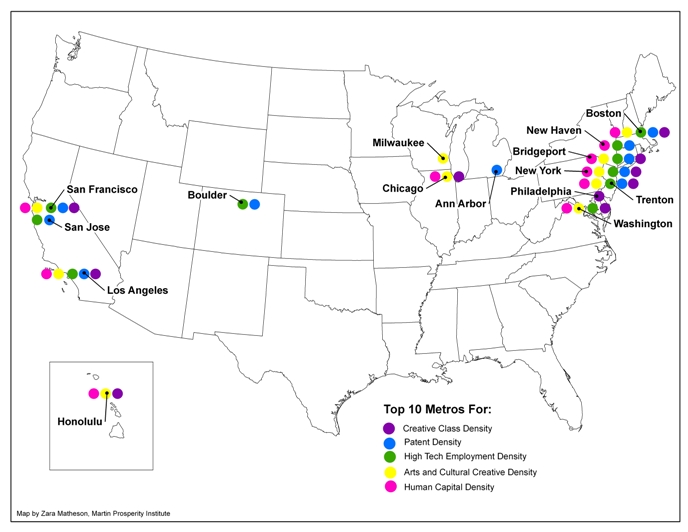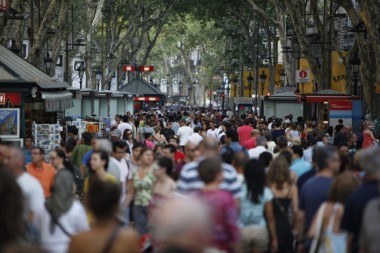 Bring people together in a great place and great things happen.This is part four in a series on “great places.” Read parts one, two, three, and five.
Bring people together in a great place and great things happen.This is part four in a series on “great places.” Read parts one, two, three, and five.
So far I’ve written that great places are green and groovy. (Yeah, I said groovy.) Lest I make the whole notion sound like a smelly commune, though, it’s worth noting that great places are also fecund: They generate economic and social capital. Done right, density can be an engine of prosperity. Business executives should love great places just as much as hippies like me do.
Here’s the basic idea: When smart, skilled people start to gather in a place, the process becomes self-perpetuating. More smart, skilled people show up to be near the others. And the more smart, skilled people you get close together, the more you reduce transaction costs and increase “knowledge spillover,” which leads to commerce and innovation. That’s true not only for individuals but for industries and research institutions (universities, labs, etc.). In economic nerdspeak, this phenomenon is known as the “economies of agglomeration.” It concrete terms, it means, as Ed Glaeser put it recently, that “wages and productivity rise with density.”
There’s a lot of research going on around this now, and I don’t want to overstate how settled the scholarship is, but the basic idea is pretty intuitive. After all, the metropolitan areas where people and businesses cluster are the engines of the U.S. economy. America’s top 100 metropolitan areas cover about 12 percent of its land but produced, in 2008, around 75 percent of its GDP. The top six metros alone generated more than 25 percent. According to a 2009 analysis by Brookings, in 47 out of 50 states, the bulk of the economic output comes from metropolitan areas. In 15 states, a single large metropolitan area produces the majority of economic output. Cities are also the source of most patents, a reasonable proxy for innovation.
So cities are already where the economic action is. And managing metros well is only going to get more important in coming years. Consider a few demographic and economic trends that are driving accelerated urbanization: The U.S. population is getting older on average; Baby Boomers are retiring, looking to downsize and get closer to amenities. Men and women are marrying later, meaning there are lots more young, single people looking for vibrant job and mating markets. When they do get married, they’re having fewer kids (a trend exacerbated by the recession), and smaller families tend to live closer to urban cores.
In short, lots of people are headed for cities, and density, which declined in the ’80s and ’90s, is destined to head back up. And while economies of agglomeration are not as strong for old-school, land-intensive businesses like heavy manufacturing, warehousing, and big-box retail, for the innovative service and knowledge jobs that increasingly dominate the U.S. economy, getting people in close proximity is a huge boost. All those incoming people could be an enormous asset for cities that know what to do with them.
So what can cities do to maximize the benefits of this inflow? What makes for an economically great place? I asked Bruce Katz, head of Brookings’ excellent Metropolitan Policy Program, and he emphasized that smart growth alone is not enough. “What you want is great places that are built on great economic bases,” he said. “The two really need to go together. What I argue for is economy-shaping, talent-preparing, and placemaking, all together.”
So smart density cannot yield economic flourishing all on its own; cities need to focus on their tradeable sectors, research institutions, and worker training programs. Nonetheless, smart density lays the groundwork for agglomeration economies to emerge and can accelerate and strengthen them when they do. So how can places do density right, to encourage great (economic) places to take root and grow?
Trying to accommodate population inflow with low-density sprawl doesn’t work. First, it increases the cost of infrastructure (roads, sewers) and services (police, fire departments). Given the grim state of federal and state budgets, “the fiscal arguments matter even more today,” said Katz. “If you don’t have those costs, you’re able to invest in what matters. Density yields fiscal rectitude.”
Second, sprawl creates congestion. And as the 2010 Urban Mobility Report reveals, the costs of congestion are getting out of hand: “measured in constant 2009 dollars, the cost of congestion has risen from $24 billion in 1982 to $115 billion in 2009.” If that doesn’t convince you, long commutes also cause “obesity, neck pain, loneliness, divorce, stress, and insomnia.” People tend to overestimate the hedonic benefits of owning a car, in part because they underestimate how much being in traffic suuucks.
And third, sprawl thins out the labor pool, which reduces innovation and productivity. Conversely, density that’s well-served by multi-modal transportation systems has the effect of “thickening” the job market, giving more people better access to more opportunities. A 2000 paper by scholar Robert Cervero found that “employment densities and urban primacy are positively associated with worker productivity.” (There’s a bumper sticker for you.)
Density served by effective transit systems — “accessible cities” — can also serve the cause of economic justice, by widening the “laborshed” of low-income people without cars, but “you really have to be intentional about that,” Katz notes. “You’ve got to build in inclusionary zoning.” But that’s probably a subject for another post …
Anyway, accessible cities are attractive to the very people cities need to attract these days: the educated, the skilled, the creative, the entrepreneurial. What else do those folks want out of a place, besides robust economic opportunities and walkable, liveable communities? Well, they want urbane and tolerant culture, plentiful amenities, and competently delivered services. In short, they want great places. As Richard Florida argued in a series of posts at The Atlantic last year, “human capital density, creative class density, artistic and cultural density, [and] high-tech and innovation density” are often found in the same places:

That’s no accident. The brightest and most ambitious people tend to follow one another to the same places. They cluster.
 Obviously, one question for progressives is how to produce more bright and ambitious people. That gets into education policy, pre-natal care, and all sorts of other areas. But another, equally important question is, how can we create more places where such people gather and flourish? How can the benefits of smart density, reflected in the map above, be spread more widely? What can a national political movement do to empower metropolitan areas to become great places, so that more Americans have a chance to live in one? That’s what this series is about; that, I argue, is what progressive politics should be about.
Obviously, one question for progressives is how to produce more bright and ambitious people. That gets into education policy, pre-natal care, and all sorts of other areas. But another, equally important question is, how can we create more places where such people gather and flourish? How can the benefits of smart density, reflected in the map above, be spread more widely? What can a national political movement do to empower metropolitan areas to become great places, so that more Americans have a chance to live in one? That’s what this series is about; that, I argue, is what progressive politics should be about.
Next: “Great places and the element of delight (plus lasers!)“


